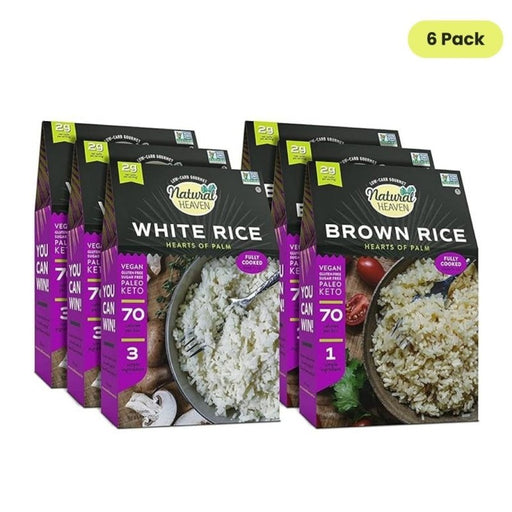Rice is a staple food for over half the world’s population, integral to cuisines in more than 100 countries. With more than 40,000 varieties available, rice is versatile and beloved, appearing in dishes from Spain’s paella to Japan’s sushi. However, in recent years, its place in our diet has been questioned, especially with the rise of low-carb diets like Keto and Paleo. So, is rice healthy? Let’s explore the nutrition facts and provide some practical tips for incorporating rice into a balanced diet.
The Basics of Rice: Brown vs. White
Brown rice is often hailed as the healthier choice compared to its refined counterpart, white rice. But what exactly sets them apart? Brown rice retains its fibrous bran layer, which makes it a whole grain. This layer gives brown rice a chewier texture and a nuttier flavor, while also increasing its cooking time and digestive duration.
In contrast, white rice is simply brown rice that has been milled and polished, removing the bran and germ. This process not only changes the flavor and texture but also extends the shelf life of the rice.
Despite these differences, both types of rice can be part of a healthy diet. Brown rice is rich in fiber, manganese, selenium, magnesium, and B vitamins, making it a nutrient powerhouse. Dietary guidelines recommend that at least half of our grain intake be from whole grains, which includes brown rice.
On the other hand, white rice, often viewed as a “bad carb,” is usually enriched with essential nutrients such as iron and B vitamins, ensuring it too offers nutritional benefits.
Understanding Rice Varieties
Rice comes in three primary grain types: long, medium, and short grain. Each type offers a unique texture and is suited to different culinary uses.
Long-grain rice like Basmati and Jasmine is known for its firm, dry texture, which helps the grains stay separate after cooking. This makes it ideal for dishes where you want distinct grains, such as pilaf or fried rice.
Medium-grain rice like Valencia is tender and moist, making it perfect for creamy dishes such as risotto or paella. The grains tend to stick together, creating a cohesive texture.
Short-grain rice, including varieties like Arborio and sushi rice, has a soft and sticky texture, which is ideal for dishes that require a denser, more compact structure. This type of rice is essential for creating the creamy consistency of risotto or the adhesive quality needed for sushi.
Is Rice Healthy and Nutritious?
Rice is an excellent source of carbohydrates, the body's primary fuel source, crucial for maintaining energy levels and supporting physical activity. White rice offers a low-carb alternative that mimics the texture and appearance of traditional white rice, providing similar satisfaction with fewer carbohydrates.
Brown rice, with its retained bran layer, is particularly rich in nutrients. It offers dietary fiber, which aids in digestion and helps maintain a healthy weight. It also provides essential minerals such as magnesium and selenium, which are important for various bodily functions, including enzyme activity and immune system support.
Despite its bad reputation among some health enthusiasts, even white rice can be a part of a balanced diet. It is often fortified with vitamins and minerals, making it a valuable source of nutrients, especially in regions where food fortification programs help combat malnutrition.
Debunking Rice Myths
One common concern is the arsenic content in rice. Rice tends to absorb arsenic more readily than other crops due to its growing conditions. However, studies, including those by the FDA, indicate that cooking methods can reduce the arsenic content by up to 60%. Consuming rice as part of a varied diet poses minimal risk and provides a range of nutrients.
Another misconception is that white rice is an “empty” or “bad” carb. While it does lose some nutrients during processing, white rice is typically enriched with iron and B vitamins. Thus, it remains a good nutritional choice, especially in diets that include a variety of food groups.
Tips for Incorporating Rice into Your Diet
Incorporating rice into a balanced diet is easy and beneficial. The key is moderation and variety. Brown rice, with its higher fiber content, is a great option for those looking to improve their digestion and maintain steady energy levels. It pairs well with vegetables, lean proteins, and healthy fats, creating a well-rounded meal.
Hearts of palm brown rice is a fantastic low-carb alternative for those on specific diets like Keto or Paleo. It provides the satisfaction of traditional rice dishes without the high carbohydrate content, making it easier to stick to dietary goals while enjoying familiar flavors.
Long-grain varieties like Jasmine or Basmati can add a delightful texture and aroma to meals. For a delicious and healthy dish, try cooking Jasmine rice with a touch of coconut milk for added flavor and nutritional benefits.
Embracing Rice as Part of a Healthy Diet
Rice is more than just a staple food; it’s a versatile and nutritious ingredient that can fit into almost any diet. At Natural Heaven, we believe in providing delicious and healthy food alternatives. Explore our range of rice products made from sustainably harvested hearts of palm, and join us in the journey towards better eating. Visit our collection today to discover how you can enjoy your favorite dishes guilt-free!












